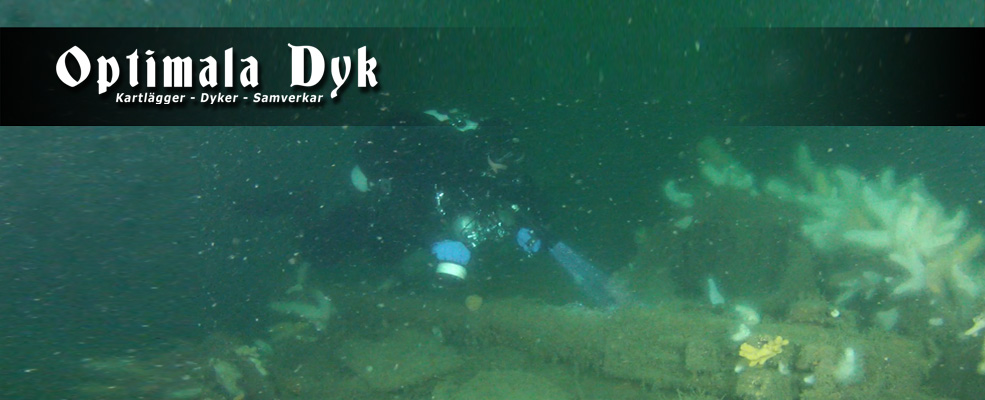
Ostmark was built in 1932 in St. Nazaire, France. The ship was originally named Côte d'Argent and served as a ferry between Calais in France and Dover in England. As France was occupied by the Germans in the summer of 1940 the ship was confiscated. Its size and shaping made it ideal for carrying mines and consequently it was rebuilt as a minelayer. In 1941 the ship was ready for service in the German Kriegsmarine, now under the name of Ostmark.
During the middle of April 1945, Ostmark was in Norway on a mine laying mission but due to bad weather it had to be aborted and the mines were off loaded. Ostmark was then, together with some other ships, ordered south to Copenhagen.
Shortly after midnight on April 21st Ostmark was attacked by British aircraft operating over the Kattegat. After several bombs had been dropped Ostmark was hit by two bombs. The first one hit the foredeck where also ammunition was stored. The explosion was very powerful and parts of the stern were blown off the ship. The second bomb struck between the bridge and the chimney, causing the vessel to catch fire. Shortly after Ostmark got a list and the crew was ordered to abandon the ship. Lifeboats were launched and at 0100 hrs Ostmark capsized. The crew on the other German vessels nearby took on board the survivors.
In mid September, as the Kattegat showed itself from its best side, we took the opportunity to go out to the wreck of the German mine layer, which is located 25 km outside the town Halmstad, Sweden, halfway out to the island of Anholt.
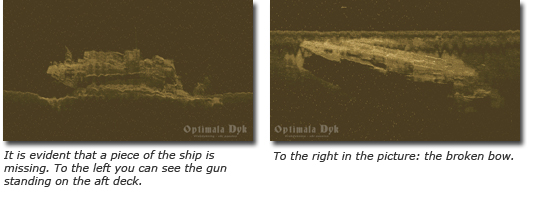
When we arrive at the location where the wreck lies we carefully drive over it. With the help of the sonar´s Structurscan, we get a good overview of the wreckage area. The wreck is huge, over 3000 brt. It is 103 m long and 14 m wide. The depth is 43 m at the bottom and 32 m at the highest parts, about as high as a house with four floors. On the sonar, we see that the wreck lies more or less right on the bottom, with a slight list to starboard. We also see clearly that a large part of the bow is missing.
Using the image from the sonar, we notice an exact location of the wreck where we want to come down and then we let down a plummet with the descent line at the position we have marked out.
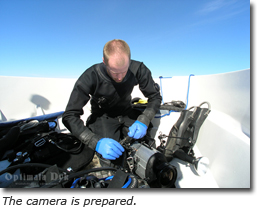
We are preparing to go down and film the wreck. After making the final checks of the equipment and we made ourselves ready to go we jump into the water. There is hardly any current at the surface and we gather at the descent line. After taking a few calming breaths at the surface we give each other a sign that we are ready and we begin our descent down towards the wreck.
We follow the line down. From a depth of 20 m depth we see the wreck below us where it starts at 32 m depth.
Below us we see the wreck with its huge port side. We land on the deck where the plummet has landed just aft of the skylight. Visibility is very good. Around the skylight several boxes are located. In one of the boxes, we see something that looks like storage containers, possibly with fog acid used to put out smoke screens for protection.

In front of the skylight we pass over the great chimney foundation and on to the bridge. It was here Ostmark received one of the bombs dropped during the night when the ship sunk. Here the destruction is severe. The large bridge in front of the foundation where the chimney once stood has collapsed dramatically, partly because of the fierce battle in April 1945 when the ship sunk, partly due to the time the ship has lied at the bottom of the sea. It is possible to swim into the remains of the superstructure. In here there are a lot of debris and wires are hanging from the ceiling everywhere.
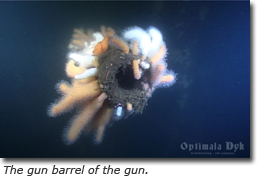
In front of the bridge most of the ship is destroyed. It was here that the attacking planes got their first hit. Everything is a jumble of sheet metal and nets. Lots of trawl nets are stuck in the whole area and it is very difficult to see what is what. Large parts of the bow are missing, which we could earlier on the StructureScan image of the wreck. We round the remains of the bow and head towards the stern.
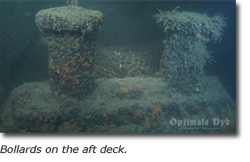
As we approach the stern, we go outside the starboard side, peering in through the large windows toward the mine deck. Inside we see the rails that were used to transport the mines on. On the aft deck, there is a cannon entangled in trawl nets.
